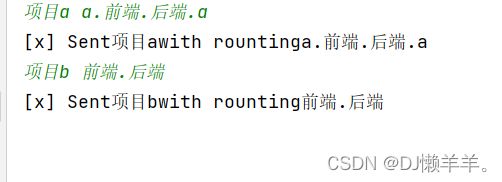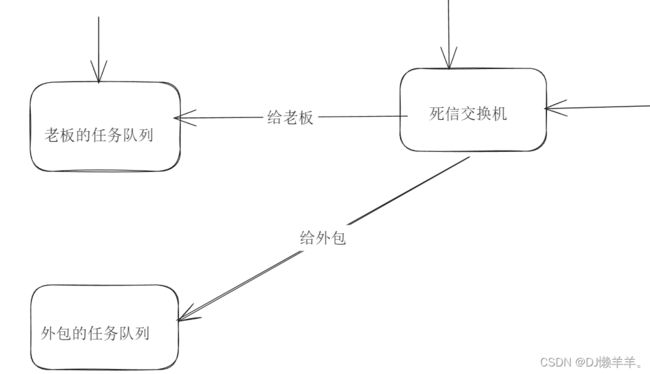分布式消息队列:Rabbitmq(2)
目录
一:交换机
1:Direct交换机
1.1生产者端代码:
1.2:消费者端代码:
2:Topic主题交换机
2.1:生产者代码:
2.2:消费者代码:
二:核心特性
2.1:消息过期机制
2.1.1:给队列中的全部消息指定过期时间
2.1.2:给某条消息指定过期时间
2.2:死信队列
一:交换机
1:Direct交换机
绑定:让交换机和队列进行关联,可以指定让交换机把什么样的消息发送给队列。
rountingkey:路由键,控制消息要发送哪个队列。
特点:根据路由键指定要转发到指定的队列
场景:特定的消息指定给特定的队列
1.1生产者端代码:
我们规定,通过控制台输入消息和路由,来指定谁完成该任务。
import com.rabbitmq.client.Channel;
import com.rabbitmq.client.Connection;
import com.rabbitmq.client.ConnectionFactory;
import java.util.Scanner;
public class DirectProducer {
private static final String EXCHANGE_NAME = "2";
public static void main(String[] argv) throws Exception {
ConnectionFactory factory = new ConnectionFactory();
factory.setHost("localhost");
try (Connection connection = factory.newConnection();
Channel channel = connection.createChannel()) {
//创建交换机的名称
channel.exchangeDeclare(EXCHANGE_NAME, "direct");
Scanner scanner=new Scanner(System.in);
while(scanner.hasNext()){
String userInput=scanner.nextLine();
String[] s = userInput.split(" ");
if(s.length<1){
continue;
}
//指定路由key
String message=s[0];
String routingKey=s[1];
//发布消息
/*
第一个参数:发布到哪个交换机
第二个参数:路由键
*/
channel.basicPublish(EXCHANGE_NAME,routingKey,null,message.getBytes("UTF-8"));
System.out.println("[x] Sent"+message+"with rounting"+routingKey+" ");
}
}
}
//..
}
1.2:消费者端代码:
import com.rabbitmq.client.Channel;
import com.rabbitmq.client.Connection;
import com.rabbitmq.client.ConnectionFactory;
import java.util.Scanner;
public class DirectProducer {
private static final String EXCHANGE_NAME = "2";
public static void main(String[] argv) throws Exception {
ConnectionFactory factory = new ConnectionFactory();
factory.setHost("localhost");
try (Connection connection = factory.newConnection();
Channel channel = connection.createChannel()) {
//创建交换机的名称
channel.exchangeDeclare(EXCHANGE_NAME, "direct");
Scanner scanner=new Scanner(System.in);
while(scanner.hasNext()){
String userInput=scanner.nextLine();
String[] s = userInput.split(" ");
if(s.length<1){
continue;
}
//指定路由key
String message=s[0];
String routingKey=s[1];
//发布消息
/*
第一个参数:发布到哪个交换机
第二个参数:路由键
*/
channel.basicPublish(EXCHANGE_NAME,routingKey,null,message.getBytes("UTF-8"));
System.out.println("[x] Sent"+message+"with rounting"+routingKey+" ");
}
}
}
//..
}
运行结果:
2:Topic主题交换机
特点:消息会根据一个模糊的路由键转发到指定的队列中。
场景:特定的一类消息只交给特定的一类系统(程序来处理)。
绑定关系:模糊匹配消息队列 *:匹配一个单词 #:匹配0个或多个单词
2.1:生产者代码:
import com.rabbitmq.client.Channel;
import com.rabbitmq.client.Connection;
import com.rabbitmq.client.ConnectionFactory;
import java.util.Scanner;
public class TopicProducer {
private static final String EXCHANGE_NAME = "3";
public static void main(String[] argv) throws Exception {
ConnectionFactory factory = new ConnectionFactory();
factory.setHost("localhost");
try (Connection connection = factory.newConnection();
Channel channel = connection.createChannel()) {
channel.exchangeDeclare(EXCHANGE_NAME, "topic");
Scanner scanner=new Scanner(System.in);
while(scanner.hasNext()){
String userInput=scanner.nextLine();
String[] s = userInput.split(" ");
if(s.length<1){
continue;
}
//指定路由key
String message=s[0];
String routingKey=s[1];
//发布消息
/*
第一个参数:发布到哪个交换机
第二个参数:路由键
*/
channel.basicPublish(EXCHANGE_NAME,routingKey,null,message.getBytes("UTF-8"));
System.out.println("[x] Sent"+message+"with rounting"+routingKey+" ");
}
}
}
}
2.2:消费者代码:
import com.rabbitmq.client.Channel;
import com.rabbitmq.client.Connection;
import com.rabbitmq.client.ConnectionFactory;
import com.rabbitmq.client.DeliverCallback;
public class TopicConsumer {
private static final String EXCHANGE_NAME = "3";
public static void main(String[] argv) throws Exception {
ConnectionFactory factory = new ConnectionFactory();
factory.setHost("localhost");
Connection connection = factory.newConnection();
Channel channel = connection.createChannel();
channel.exchangeDeclare(EXCHANGE_NAME, "topic");
//创建消息队列
String queueName="fronted_queue";
channel.queueDeclare(queueName,true,false,false,null);
channel.queueBind(queueName,EXCHANGE_NAME,"#.前端.#");
String queueName2="backed-_queue";
channel.queueDeclare(queueName2,true,false,false,null);
channel.queueBind(queueName2,EXCHANGE_NAME,"#.后端.#");
String queueName3="product_queue";
channel.queueDeclare(queueName3,true,false,false,null);
channel.queueBind(queueName3,EXCHANGE_NAME,"#.产品.#");
System.out.println(" [*] Waiting for messages. To exit press CTRL+C");
DeliverCallback deliverCallback1 = (consumerTag, delivery) -> {
String message = new String(delivery.getBody(), "UTF-8");
System.out.println(" [前端] Received '" +
delivery.getEnvelope().getRoutingKey() + "':'" + message + "'");
};
DeliverCallback deliverCallback2 = (consumerTag, delivery) -> {
String message = new String(delivery.getBody(), "UTF-8");
System.out.println(" [后端] Received '" +
delivery.getEnvelope().getRoutingKey() + "':'" + message + "'");
};
DeliverCallback deliverCallback3 = (consumerTag, delivery) -> {
String message = new String(delivery.getBody(), "UTF-8");
System.out.println(" [产品] Received '" +
delivery.getEnvelope().getRoutingKey() + "':'" + message + "'");
};
channel.basicConsume(queueName, true, deliverCallback1, consumerTag -> { });
channel.basicConsume(queueName2, true, deliverCallback2, consumerTag -> { });
channel.basicConsume(queueName3, true, deliverCallback3, consumerTag -> { });
}
}
运行结果:
二:核心特性
2.1:消息过期机制
特点:给每条消息指定一个有效期,一段时间内未被消费,就过期了。
2.1.1:给队列中的全部消息指定过期时间
在消费者中对于队列的全部消息指定过期时间,如果在过期时间内,还没有消费者取消息,消息才会过期,如果消息已经接收到,但是没确认,是不会过期的。
public class TTLConsumer {
private final static String QUEUE_NAME = "ttl_queue";
public static void main(String[] argv) throws Exception {
//创建连接工厂
ConnectionFactory factory = new ConnectionFactory();
factory.setHost("localhost");
//创建频道,提供通信
Connection connection = factory.newConnection();
Channel channel = connection.createChannel();
//指定消息队列的过期时间
Map args=new HashMap<>();
args.put("x-message-ttl",5000);
//args:指定参数
channel.queueDeclare(QUEUE_NAME, false, false,false, args);
System.out.println(" [*] Waiting for messages. To exit press CTRL+C");
//如何处理消息
DeliverCallback deliverCallback = (consumerTag, delivery) -> {
String message = new String(delivery.getBody(), "UTF-8");
System.out.println(" [x] Received '" + message + "'");
};
channel.basicConsume(QUEUE_NAME, false, deliverCallback, consumerTag -> { });
}
}
2.1.2:给某条消息指定过期时间
//在发送者这边设置过期时间
public class TTLProducer {
private final static String QUEUE_NAME = "ttl_queue";
public static void main(String[] argv) throws Exception {
//创建连接工厂
ConnectionFactory factory = new ConnectionFactory();
factory.setHost("localhost");
try (Connection connection = factory.newConnection();
//频道相当于客户端(jdbcClient,redisClient),提供了和消队列server建立通信,程序通过channel进行发送消息
Channel channel = connection.createChannel()) {
//创建消息队列,第二个参数(durable):是否开启持久化,第三个参数exclusiove:是否允许当前这个创建消息队列的
//连接操作消息队列 第四个参数:没有人使用队列,是否需要删除
String message = "Hello World!";
//给消息指定过期时间
AMQP.BasicProperties properties=new AMQP.BasicProperties.Builder()
.expiration("1000")
.build();
channel.basicPublish("", QUEUE_NAME, properties, message.getBytes(StandardCharsets.UTF_8));
System.out.println(" [x] Sent '" + message + "'");
}
}
2.2:死信队列
为了保证消息的可靠性,比如每条消息都成功消费,需要提供一个容错机制,即失败的消息怎么处理,相当于死信。
死信:过期的消息,拒收的消息,处理失败的消息,消息队列满了统称为死信。
死信队列:处理死信的队列。
死信交换机:给死信队列发送消息的交换机,也存在路由绑定。
a:创建死信交换机和死信队列
//声明死信交换机
channel.exchangeDeclare(WORK_NAME,"direct");
//声明死信队列
String queueName="boss_queue";
channel.queueDeclare(queueName,true,false,false,null);
channel.queueBind(queueName,EXCHANGE_Name,"boss");
String queueName2="waibao_queue";
channel.queueDeclare(queueName2, false, false, false, null);
channel.queueBind(queueName2,EXCHANGE_Name,"waibao");b:给失败后的需要容错的队列绑定死信交换机
//声明交换机
channel.exchangeDeclare(WORK_NAME, "direct");
Map map=new HashMap<>();
//声明要绑定的死信交换机
map.put("x-dead-letter-exchange",DEAD_EXCHANGE_NAME);
//声明要绑定的死信队列
map.put("x-dead-letter-routing-key","waibao_queue");
//创建消息队列
String queueName="xiaodog_queue";
channel.queueDeclare(queueName,true,false,false,map);
channel.queueBind(queueName,WORK_NAME,"xiaodog");
Map map2=new HashMap<>();
//声明要绑定的死信交换机
map2.put("x-dead-letter-exchange",DEAD_EXCHANGE_NAME);
map2.put("x-dead-letter-routing-key","boss_queue");
String queueName2="xiaocat_queue";
channel.queueDeclare(queueName2,true,false,false,map2);
channel.queueBind(queueName2,WORK_NAME,"xiaocat");











